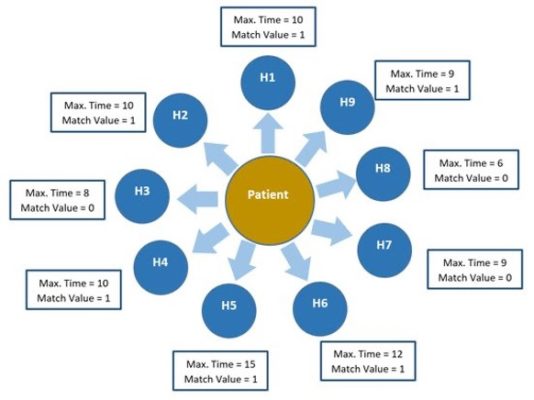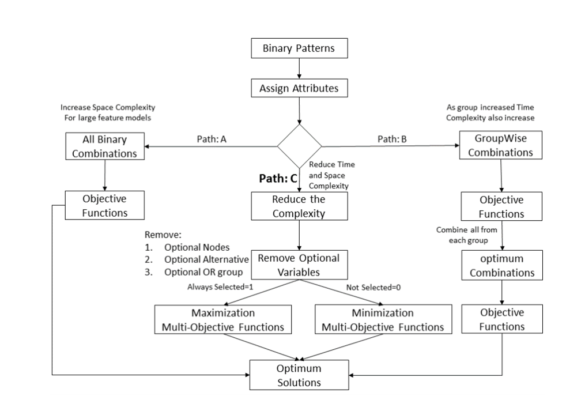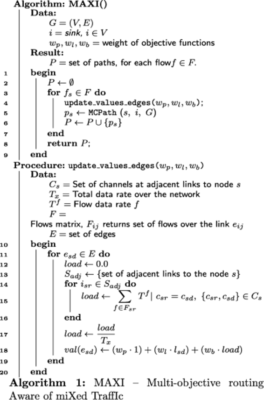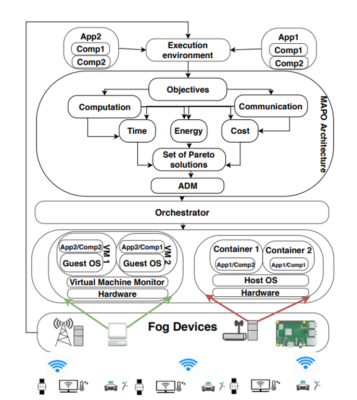Multi-Objective IoT System Modeling and Analysis—Performance, Energy, Reliability, Robustnes
Currently, Multi-Objective IoT System Modeling is a topic that many scientists, especially experts in the IoT field, are constantly researching and applying. The Global IoT Summit is held annually with IEEE support, Multi-Objective IoT System Modeling and Analysis—Performance, Energy, Reliability, Robustnes is the main topic under IoT Pilots, Testbeds and Experimentation Results are always the reporting topic. IoT annually attracts the attention of not only scientists, but also businessmen with a special interest in IoT. This article can not generalize all the huge research works, but is only based on some published articles which, according to the objective assessment of the writer, are highly applicable.
1. What is Multi-Objective Optimization (MOP)?
The majority of IoT apps have many objective functions in the same device or application. Multi-objective optimization (also known as Pareto optimization) is a type of optimization that focuses on a problem’s many characteristics. It’s ideally suited to a variety of situations involving many factors in the decision-making process. In other words, it’s an optimization method that works with numerous objective functions. It entails optimizing two or more objective functions at the same time. Multiple objective optimization has been utilized in a variety of situations where optimum judgments must be made while two or more goals are at odds.
To make it simpler to grasp, we’ll use two particular examples: reducing time while maximizing reliability and optimizing performance while minimizing costs.
 Figure 1: A Multi-Objective Optimization model based on the status of patients infected with Covid-19
Figure 1: A Multi-Objective Optimization model based on the status of patients infected with Covid-19
The reality is that there isn’t a single solution that achieves both goals. When one value is higher than another, the other value may lead to deterioration. There are a number of solutions with contradicting objective function values; in other words, if we compare two solutions, one has a lower cost while the other has a higher reliability. In such a situation, both methods might be regarded as viable options. Which one is chosen is determined by the customer’s requirements. There is no way to sort out the solutions.
A collection of solutions known as multi-objective optimization reveals the optimum trade-off between conflicting objectives. In multi-objective optimization, dominance determines the solution’s superiority.
2. Introducing some typical Multi-Objective IoT System Models
2.1. Multi-Objective Optimum Solutions for IoT-Based Feature Models of Software Product Line
a) Model introduction
The Software Product Line (SPL) is widely used in the software industry for the development of software families with core common and changeable functions. SPL is used in industry to improve feature reusability, reduce development costs, and shorten time to market, all of which lead to improved product development. SPL development is divided into two stages: core development and application development.
- The first is SPL’s variable features and development of common under the domain of SPL.
- The second is the process of creating a product by combining existing common and variable features to meet the needs of stakeholders. Existing common and variable features are being developed, spending money and time ahead of time without any product derivation that may be remunerated by reusability in the creation of numerous goods.
The Feature Model (FM) is a tree structure that manages SPL’s common and variable features. Alternative, optional, and OR groups predefine constrains and relationships between features in FM, which is a compact picture of all goods under the domain of SPL. The product is developed based on the FM’s desired features, which meet the functional criteria and quality attributes of the stakeholders. Due to the complexity of linkages and constraints, selecting features according to stakeholder needs is a challenging and time-consuming job in a large FM configuration space. Stakeholder needs for reduced memory usage, lower cost, and excellent performance are not fulfilled at a single point during product configuration. As a result, SPL developers must weigh the trade-offs between competing goals.
SPL is used to control contextual variability and to make IoT application features more reusable. However, owing to the substantial contextual heterogeneity in IoT contexts, selecting the appropriate IoT application development features based on end-user objectives is a difficult process. To meet the end user’s goals, optimization is the most effective way to choose the greatest features.
b) How the model works?
The Multi-Objective Optimum (MOO)-BPNCC algorithm, which computes all possible combinations of SPL products without any constraint violations, is used to generate totally accurate optimal solutions from big and small FMs without constraint violations.
 Figure 2: MOO-BPNCC
Figure 2: MOO-BPNCC
(source: IEEE Xplore Full-Text PDF: (ieeexplore.ieee.org))
MOO-BPNCC is an extension of BPNCC and consists of three independent paths to acquire optimum solutions.
- Path A applies objective functions to all configurations for the best results. However, for large FMs with millions of product configurations, this path increases space and time complexity.
- Path B applies the objective functions to each group one by one, finding the best combinations from each, and then combining all of the groups’ best solutions.
- Path C lowers FM’s complexity by removing optional features with constant values, such as 0 for reduction and 1 for maximizing objective functions.
c) Result
Each approach path will have its own advantages and disadvantages. However, path C is more achievable when there is less execution time and space and the complexity of feature combinations is reduced by ignoring the optional FM variables throughout the optimal procedure. Path C is the most effective method for obtaining the optimal feature combinations for product derivations.
2.2 Multi-objective routing aware of mixed IoT traffic for low-cost wireless Backhauls (MAXI)
a) MAXI model introduction
The use of low-cost techniques, such as infrastructure and spectrum sharing, as well as heterogeneous networks made up of current technology, is encouraged. In heterogeneous networks, Wi-Fi and ZigBee are the most widely utilized and low-cost wireless technologies.
Low-cost Wireless Backhauls (LWBs) are based on WiFi technology and can be used to expand a mobile operator’s network access infrastructure. Because of features such as low cost, portability, and adaptability of the equipment deployed, LWBs have made the Internet ubiquitous.
The model is an extension of the multi-objective routing ILP model used in Wireless Sensor Networks (WSNs) to the routing optimization issue in WMNs towards IoT systems, with an emphasis on multimedia applications and WSN sensing data. Three goals underpin the routing problem.
- Firstly, reduce the length of the route (number of hops).
- Secondly, reduce the bottleneck.
- Thirdly, reduce the path’s interference.
b) How the MAXI model works?
In a network that depicts a WMN, the MAXI utilizes an algorithm to find pathways at a reduced cost (e.g., Dijkstra’s algorithm). Three weighted objective functions are combined in the MAXI algorithm.
- Firstly, path length minimization.
- Secondly, minimization of links with low quality.
- Thirdly, mitigation of network bottlenecks.
 Figure 3: MAXI
Figure 3: MAXI
c) Result
MAXI is a routing system that can handle a variety of mixed traffic requirements. It can improve overall mixed traffic performance by catering to the needs of each application in a mixed IoT system.
2.3 A Multi-Objective Model for IoT Application Placement in a Fog Environment (MAPO)
a) MAPO model overview
Fog computing is a novel paradigm that shifts some processing of latency-sensitive IoT applications from the Cloud to the network’s edge, where the data is created. To properly manage the execution of distributed applications in a highly diverse environment with limited processing capabilities, the fog model becomes important.
In a heterogeneous Fog computing environment, Multi objective IoT Application Placement in Fog (MAPO), customized for individual IoT applications, is described as a series of lightweight linked components, deployed either as microservices or as functional modules. A genetic multi-objective optimization method that takes three opposing criteria into consideration.
- Firstly, economic cost.
- Secondly, energy consumption.
- Thirdly, completion time.
b) How the MAPO model works?
- Firstly, many different users use applications with many interconnected components. Applications are built on Fog’s MAPO execution environment.
- Secondly, it determines the linkages between application components and gives the multi-objective optimization algorithm placement constraints to find a Pareto set of tradeoff solutions.
- Thirdly, the multi-objective optimization uses a rapid evolutionary Non-Dominated Sorting Genetic Algorithm (NSGA-II) to find a set of non-dominated Pareto placements of application components on a collection of Fog devices.
- Fourthly, based on a low latency strategy, an automated decision-making module determines an optimal placement.
- Finally, MAPO sends the chosen placement to a Docker Swarm orchestrator.
 Figure 4: MAPO
Figure 4: MAPO
(source: 1908.01153.pdf (arxiv.org))
c) Result
It provides cost-aware application management, reduced power consumption, and lower execution time.
MAPO helps reduce application completion time, Fog helps save energy for small applications that do not require high computing resources. In addition, the communication time delay is also improved to lead to real-time communication.
Benefits of Multi-Objective IoT System
Help fast-growing products, especially IoT products, at a low cost and get products to market faster by reusing existing resources.
Optimize by combining multiple functions on one IoT device most effectively to avoid possible conflicts.
Applications are all grouped according to IoT sush as:
- Devices in smarthomes and smart buildings.
- Clothing with built-in devices.
- Multimedia devices (smartphones, microphones, video cameras, etc).
- Implantable devices (continuous glucose monitoring, gastric pressure measurement, etc).
- Wearable devices (bracelets, watches, etc).
Reduce the latency of IoT devices, especially those in the medical industry. It helps provide real-time situational information.
 Figure 5: Augmented reality for medical industry
Figure 5: Augmented reality for medical industry
(source: 1908.01153.pdf (arxiv.org))
It helps optimize energy efficiency while helping to save costs on energy use. Using available renewable energy sources increases the ability to protect the environment.
Future of Multi-Objective IoT System
Cross-tree restrictions and goal-based optimization help to improve the best solutions.
Carry out a multi-objective optimization with a specified function as the priority.
Wireless Sensor Networks (WSNs) can be connected to Wireless Mesh Networks (WMNs) through bridge technology (Raspberry Pi). It can be combined with a variety of IoT applications to provide a balance of ubiquity, cost, and performance.
It is necessary to have researched, evaluated and experimental models in which external interference is present.
The technology enables the accessibility of IoT devices with high capacity, supporting simultaneous access to a wide range of devices.
Limit both causes of transmission interference (internal caused by the network nodes themselves and externally caused by factors that are not part of the network).
Automatic tuning models for mixed IoT traffic based on sporadic and regular data.
Conclusion
Multi-Objective IoT System Modeling and Analysis—Performance, Energy, Reliability, Robustness will be further researched, applied, and developed with many models to improve different functions. This brings the future of IoT to develop quickly but sustainably, helping to optimize and save energy. This is a topic that needs many research experts and product development companies to experimentally evaluate the results achieved. From there, a general plan will be developed for the popularity and development of IoT in the future.
Source of references:
- 01153.pdf (arxiv.org)
- Multi-objective routing aware of mixed IoT traffic for low-cost wireless Backhauls | Journal of Internet Services and Applications | Full Text (springeropen.com)
- An IoT-Based Fog Computing Model – ProQuest (proquest.com)
- (PDF) Multi-Objective Optimum Solutions for IoT-Based Feature Models of Software Product Line (researchgate.net)
- Multi-objective Optimization using NSGA II for service composition in IoT – ScienceDirect (sciencedirect.com)
The post Multi-Objective IoT System Modeling and Analysis—Performance, Energy, Reliability, Robustnes appeared first on Speranza.
*** This is a Security Bloggers Network syndicated blog from IoT Blog – Speranza authored by Allen. Read the original post at: https://www.speranzainc.com/multi-objective-iot-system-modeling-and-analysis-performance-energy-reliability-robustnes/





